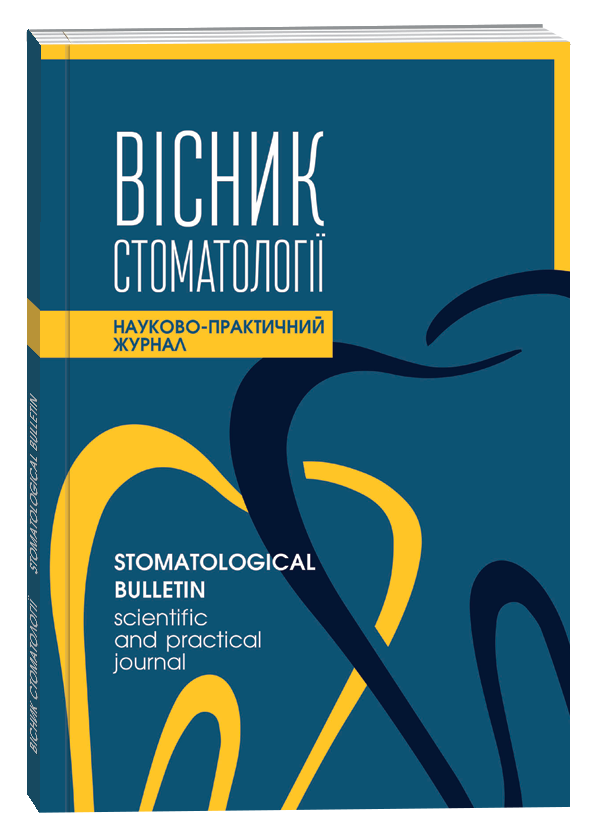METHODS OF RESTORING INTERALVEOLAR HEIGHT DURING REPEATED PROSTHETICS OF PATIENTS WITH COMPLETE SECONDARY ADENTIA
DOI:
https://doi.org/10.35220/2078-8916-2022-44-2.9Keywords:
complete secondary adentia, painful muscle and joint dysfunction, interalveolar height, step-by-step prosthetics, repeated prosthetics.Abstract
The purpose of the study. Improving the effectiveness of orthopedic treatment during repeated prosthetics of patients with reduced interalveolar height and optimizing the adaptation process to restore the physiological height of the bite. Materials and methods. We examined 209 elderly patients (according to the WHO classification) aged 60 to 75 years with a diagnosis of “complete secondary adentia” (CSA) undergoing repeated orthopedic treatment with complete removable plate prostheses (WRPP). In cases where the interalveolar height on old prostheses was reduced by 8 mm or more for various reasons, the restoration of the occlusion height was carried out in two stages. At first, in order to prevent traumatic arthritis, by half of the lost height, and after the patient adapts to new prostheses (6 months after the initial prosthetics) – finally to the desired height. The results of the study. Clinical observations have shown that a one-time increase in the height of the bite by 3–4 mm does not cause subjective concern. Therefore, if the bite height is lowered by no more than 4 mm, then it can be simultaneously raised to the desired height. In cases where the bite height on old prostheses is underestimated by 6 mm or more, the restoration of the interalveolar height should be carried out in two stages: a preliminary increase by half of the lost height (using old WRPP), and after 3–4 months, when the patient has adapted to new occlusal conditions, new prostheses finally restore the height of the lower third of the face to the desired level. The proposed technique excludes such complications during repeated prosthetics of WRPP as acute traumatic arthritis temporomandibular joint, myositis, neuralgic complications. It increases the effectiveness of orthopedic treatment during repeated prosthetics of patients with reduced interalveolar height, accelerates the adaptation of patients of the older age group to the restoration of the physiological height of the bite and contributes to the speedy normalization of chewing function.
References
Базаров Б. А. Функциональные нарушения жевательных мышц у лиц с ранними окклюзионными нарушениями Забайкальский медицинский вестник. 2011. № 1. С. 91–97.
Бугровецкая О. Г., Ким К. С., Бугровецкая Е. А. и др. Роль окклюзионных нарушений в патогенезе головной боли напряжения. Мануальная терапия. 2012. № 4. С. 33–38.
Воробьева М. В., Матыцина Т. В., Коннов В. В. и др. Профилактика функциональных нарушений височно-нижнечелюстных суставов при ортопедическом лечении пациентов с концевыми дефектами зубных рядов. Саратовский научно-медицинский журнал. 2011. № 1. С. 284–285.
Онищенко В. С. Частичная потеря зубов как фактор риска снижения высоты прикуса. Современная стоматология, 1999. № 4. С. 44–46.
Польма Л. В., Маркова М. В., Оборотистов Н. Ю. Дистальная окклюзия зубных рядов: одно- или двухэтапное лечение. Ортодонтия. 2013. № 2. С. 14–24.
Потапов В. П. Комплексный подход к диагностике и лечению нарушений функциональной окклюзии. Институт стоматологии. 2008 № 4. С. 24–25.
Пономарев А. В., Потапов В. П., Зотов В. М. и др. Комплексный подход к оценке состояния функциональной окклюзии у клинически здоровых людей. Маэстро стоматологии. 2003. № 3. С. 50–52.
Савина Е. А., Булкина Н. В., Масумова В. В., Олевская О. А. Взаимосвязь стоматологического статуса, данных самооценки и мотивации к лечению, Саратовский научно-медицинский журнал. 2011. Том 7, № 1.
Сидоренко А. Н., Кулаков А. А., Каде А. Х. Сравнительный анализ функционального состояния жевательных мышц у больных с нейромышечной дисфункцией височно-нижнечелюстных суставов при традиционном методе лечения и применении транскраниальной электростимуляции. Фундаментальные исследования. 2013. № 9. С. 132–136.
Шутурминский В. Г. Результаты изучения распространенности протезных стоматитов у лиц, протезируемых съемными пластиночными протезами. Интегративная антропология, 2015, № 1. С. 50–54. 11. Долгалев А. А., Брагин Е. А. Значение магнитно-резонансной томографии и электронной аксиографии в диагностике дисфункций височно-нижнечелюстного сустава. Стоматология. 2008. № 1. С. 56–60.









